Designing Safe, Challenging Playgrounds
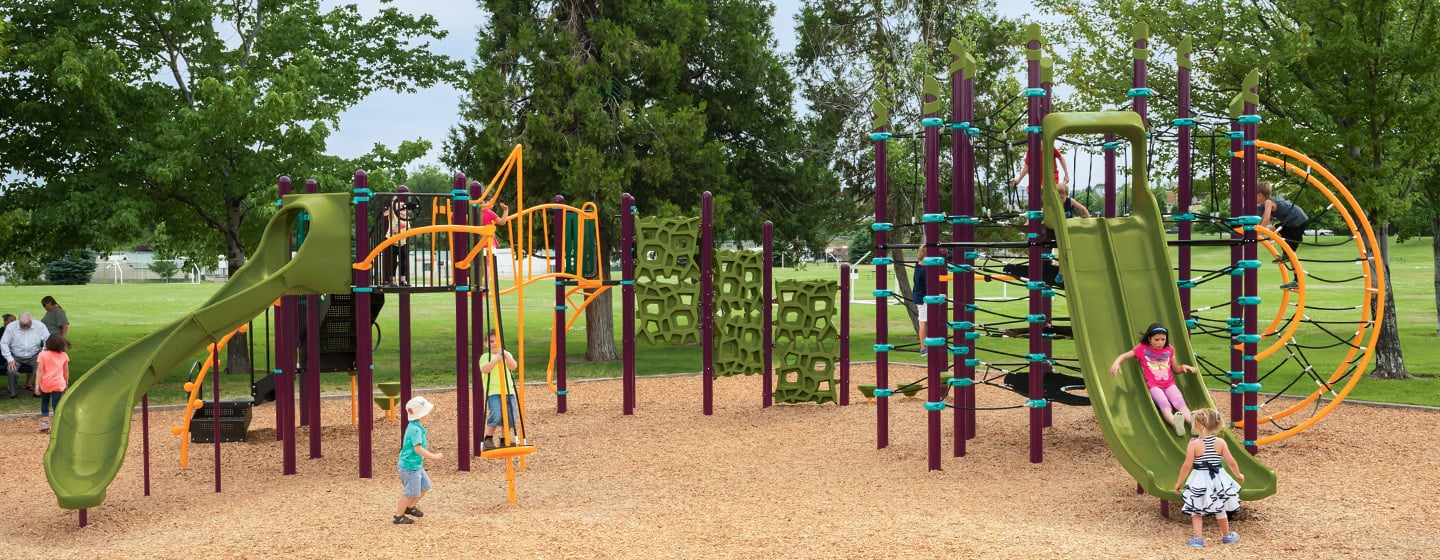
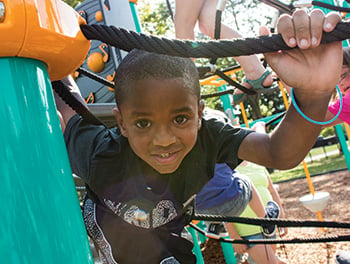 Playgrounds are a key component to a child's development offering a unique opportunity for children to play and practice skills that promote their cognitive, emotional, physical, and social development. However, this skill-building and brain and body development can't take place without age- and developmentally appropriate challenges.
Playgrounds are a key component to a child's development offering a unique opportunity for children to play and practice skills that promote their cognitive, emotional, physical, and social development. However, this skill-building and brain and body development can't take place without age- and developmentally appropriate challenges.
Playgrounds need to provide a safe environment for kids to play freely with challenges that test and teach them new skills. Unfortunately, this balance doesn't always occur. Parental concern along with increased standards and regulations are making it harder and harder to design playgrounds that include the challenging opportunities essential to childhood development.
Benefits of Challenging Playgrounds
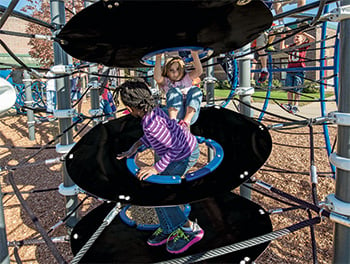 Playgrounds and outdoor play do so much more than expend a child's excess energy. Playing on a playground teaches children self-regulation, how to handle stressful situations, and increase self-confidence and self-esteem. Including exciting and interesting playground elements that test and challenge children increases these benefits.
Playgrounds and outdoor play do so much more than expend a child's excess energy. Playing on a playground teaches children self-regulation, how to handle stressful situations, and increase self-confidence and self-esteem. Including exciting and interesting playground elements that test and challenge children increases these benefits.
If a playground lacks challenging elements, children may lose interest and miss out on the benefits that coincide with play. When children are uninterested in a playground, the developmental benefits of play are lost before they begin. Playgrounds that offer exciting and challenging play activities entice children to participate and be active and fully reap the benefits of play. Research also suggests that limiting challenges and imposing too many restrictions on children's outdoor play may be hampering their development.
When risk is removed from play and restrictions are too high, children are more prone to problems such as obesity, mental health concerns, lack of independence, and a decrease in learning, perception and judgment skills. Children's engagement in risky play has an adaptive function in reducing a fear through repeated and slow exposure to that fear, like heights for example. The research shows that if children are not provided with sufficiently challenging play opportunities, they will not develop an ability to cope with fear-inducing situations and maintain their fear leading to anxiety disorders.
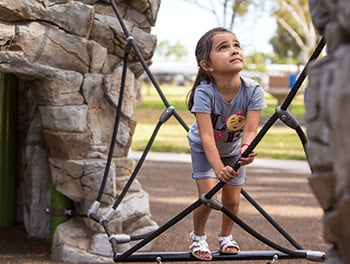 Including natural elements in playground design could be the key to encouraging more free play and instinctual risk taking – both vital to the development of a child's creativity and self-worth. A study conducted by the University of Tennessee's Department of Kinesiology, Recreation and Sport Studies, examined the differences in behavior of children on both traditional and natural playgrounds. Elements of traditional playgrounds such as swings and slides – although still developmentally beneficial – have a prescribed method of use, but natural elements, say researchers, allow a child to develop their own way of playing.
Including natural elements in playground design could be the key to encouraging more free play and instinctual risk taking – both vital to the development of a child's creativity and self-worth. A study conducted by the University of Tennessee's Department of Kinesiology, Recreation and Sport Studies, examined the differences in behavior of children on both traditional and natural playgrounds. Elements of traditional playgrounds such as swings and slides – although still developmentally beneficial – have a prescribed method of use, but natural elements, say researchers, allow a child to develop their own way of playing.
Several schools and communities are realizing these benefits with our nature-inspired playground collection. Lake Rebecca Park Reserve, in Rockford, Minn., for example, is seeing huge crowds of visitors with their big woods-themed, nature-inspired custom park. The playground design includes a tree house, log cabin and many natural elements that encourages a child's creativity and achieves the balance of challenge and safety by combining the adventure of nature with the durability, safety and low-maintenance of high-quality commercial playground equipment.
For more information about the benefits of safe and challenging play, download our whitepaper, Balancing Safety & Challenge in Playground Design.
Making Challenging Play, Safe Play
 Calling for the inclusion of more challenging elements in playgrounds doesn't come at the cost of children's safety. It is not a one or the other conversation, but a balance that must be met by considering both. Safety is, of course, important, and so is developmentally- and age-appropriate risk taking through challenging playground equipment.
Calling for the inclusion of more challenging elements in playgrounds doesn't come at the cost of children's safety. It is not a one or the other conversation, but a balance that must be met by considering both. Safety is, of course, important, and so is developmentally- and age-appropriate risk taking through challenging playground equipment.
We're committed to working with and complying with the International Play Equipment Manufacturers Association (IPEMA), the Consumer Product Safety Commission (CPSC), American Society for Testing and Materials (ASTM) and other organizations to ensure that playground equipment products are safe for children. To confirm your playground component meets IPEMA standards, visit ipema.org. We're also passionate about providing age- and developmentally appropriate challenges to enhance a child's development. Our new designs are key to making the balance between challenge and safety a possibility.
For example, our net-based climbers, boulder-climbing courses and zip line-type play components offers kids a chance to challenge themselves physically and cognitively by creating an experience completely different from those offered by traditional play structures. Children must navigate sturdy playground nets, scale rock-style facades and race down a playground zip line placed at a safe height. Designs such as these can provide appropriate challenges while removing hazards, satisfying kids, parents and regulators.
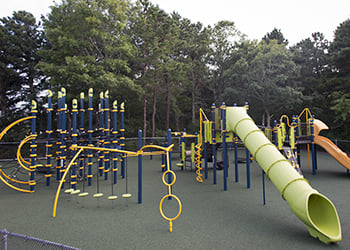 Students at Quashnet School in Mashpee, Mass., are benefiting from the age-appropriate challenge and safe exploration of net climbers. The school installed a Netplex® playstructure to keep kids active and engaged during recess allowing them to test new skills and explore challenges. The developmental benefits gained from this type of unstructured challenging play, will eventually help children become effective thinkers, leaders and collaborators.
Students at Quashnet School in Mashpee, Mass., are benefiting from the age-appropriate challenge and safe exploration of net climbers. The school installed a Netplex® playstructure to keep kids active and engaged during recess allowing them to test new skills and explore challenges. The developmental benefits gained from this type of unstructured challenging play, will eventually help children become effective thinkers, leaders and collaborators.
Implementing playground designs that include age- and developmentally appropriate challenges in a safe environment provide kids with the experiences they need to grow into well-balanced adults. A well-designed playground includes both challenging equipment and a safe and controlled environment for a child to test, assess and explore. Playgrounds should keep kids away from dangerous hazards while encouraging them to test their limits, learn to overcome challenges and take healthy risks.
For help in designing a safe and challenging playground for your community, school or organization, contact your local Landscape Structures playground consultant.
Playground Safety Factors
Important safety factors to consider when designing a playground
- Age-appropriateness of sites and play equipment. The Consumer Products Safety Commission (CPSC) recommends separate play areas for kids ages 6 to 23 months, 2- to 5-year-olds and school-age children ages 5 to 12.
- Proper installation. Site preparation and playground equipment installation can either be handled by certified professionals or you can recruit volunteers for a community build project.
- Environmental conditions. The play area should be adequately shaded to protect against sun exposure, well-drained, visible from nearby paths, away from automobile and bicycle traffic, and separated from water or other natural hazards.
- Equipment design. Playground equipment should be structurally sound, durable and engineered with safety in mind.
- Layout of play area. Children's play patterns can affect playground use. Your Landscape Structures playground consultant can help design an optimal layout to minimize congested play.
- Protective surfacing. This can be an adequate depth of a loose-fill material, wood fiber rubber mulch, factory-made resilient tiles, a unitary safety surface or a combination.
- Safety audits and safety inspections. Conduct a safety audit and implement regularly scheduled preventative maintenance inspections to catch incorrectly installed equipment, and any equipment that is broken, physically worn, damaged by vandals or weakened by the ravages of time.